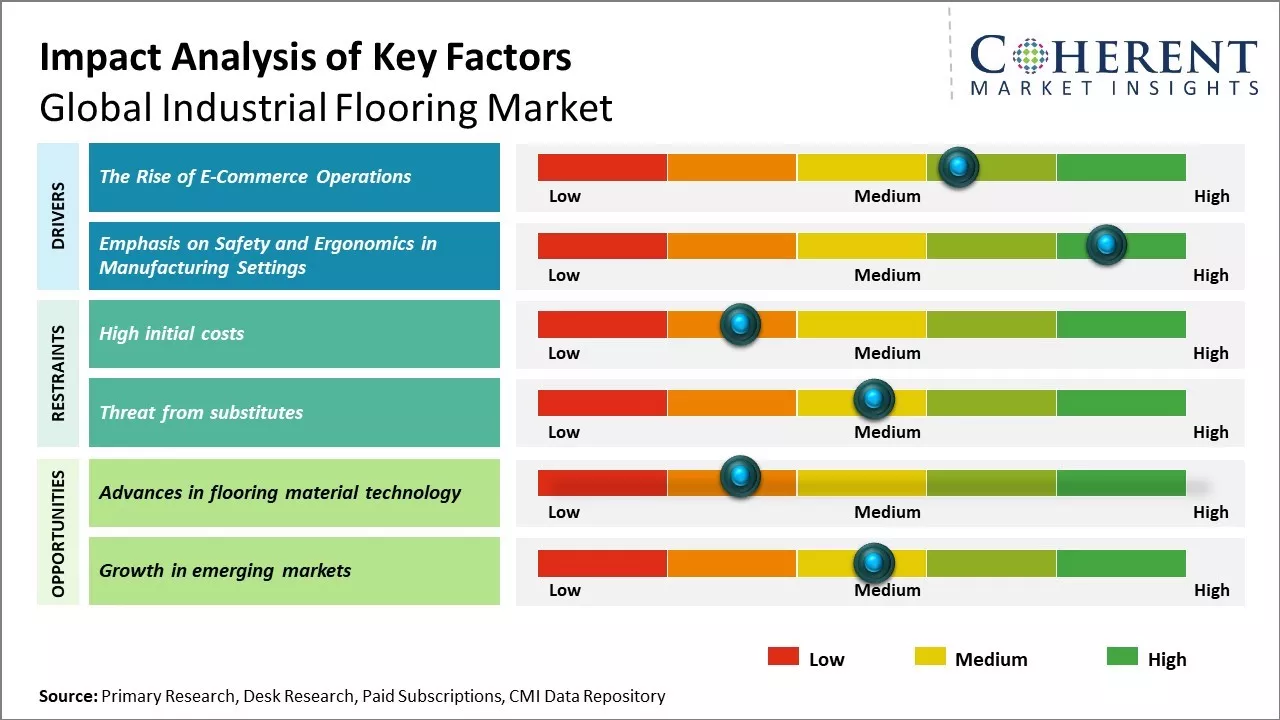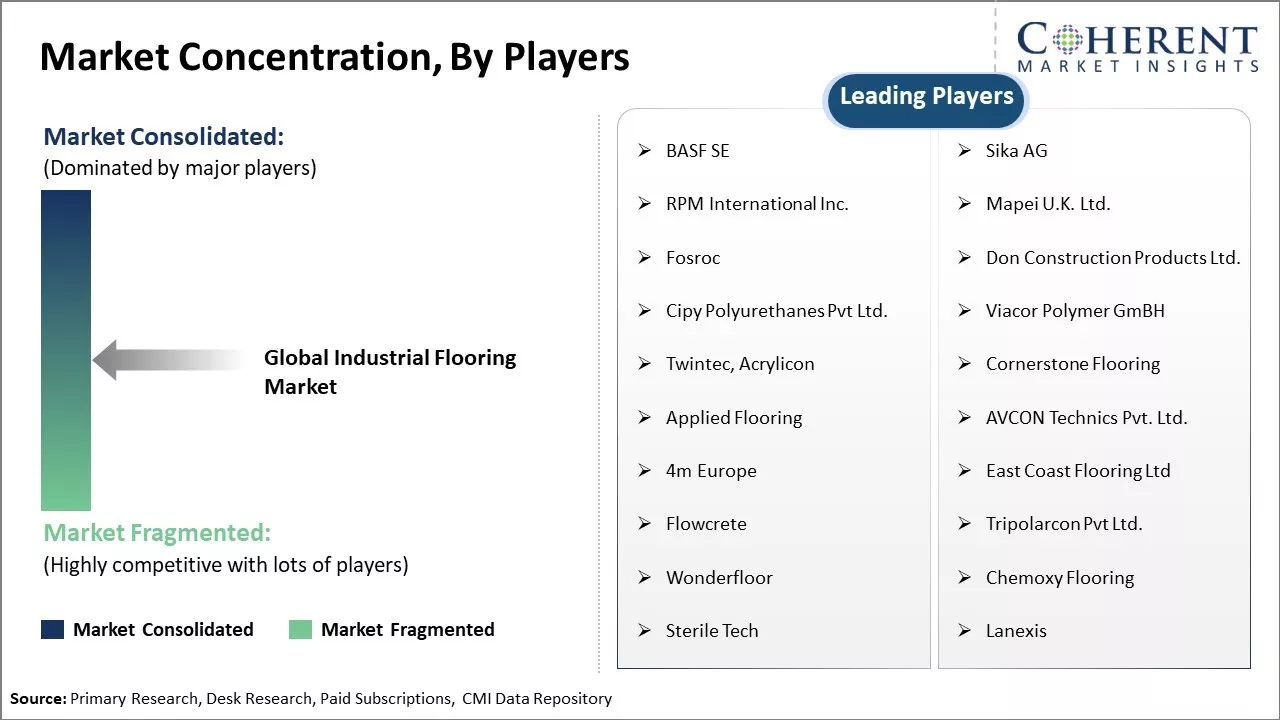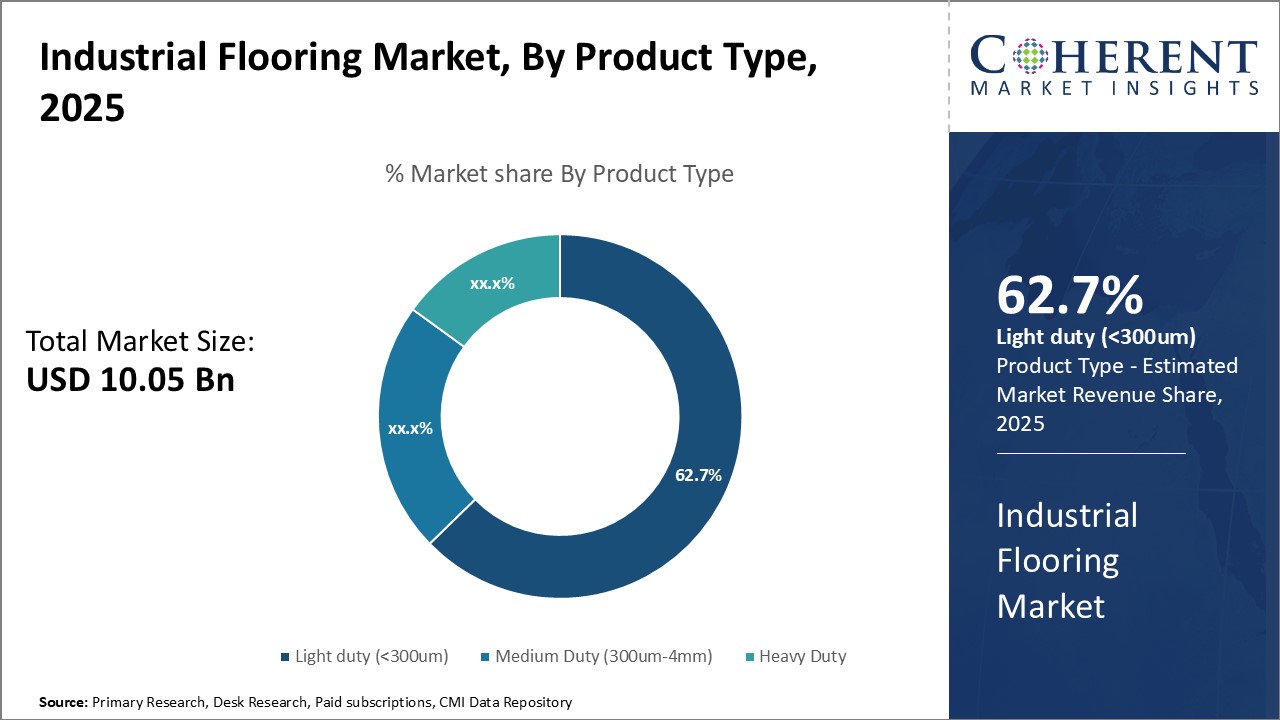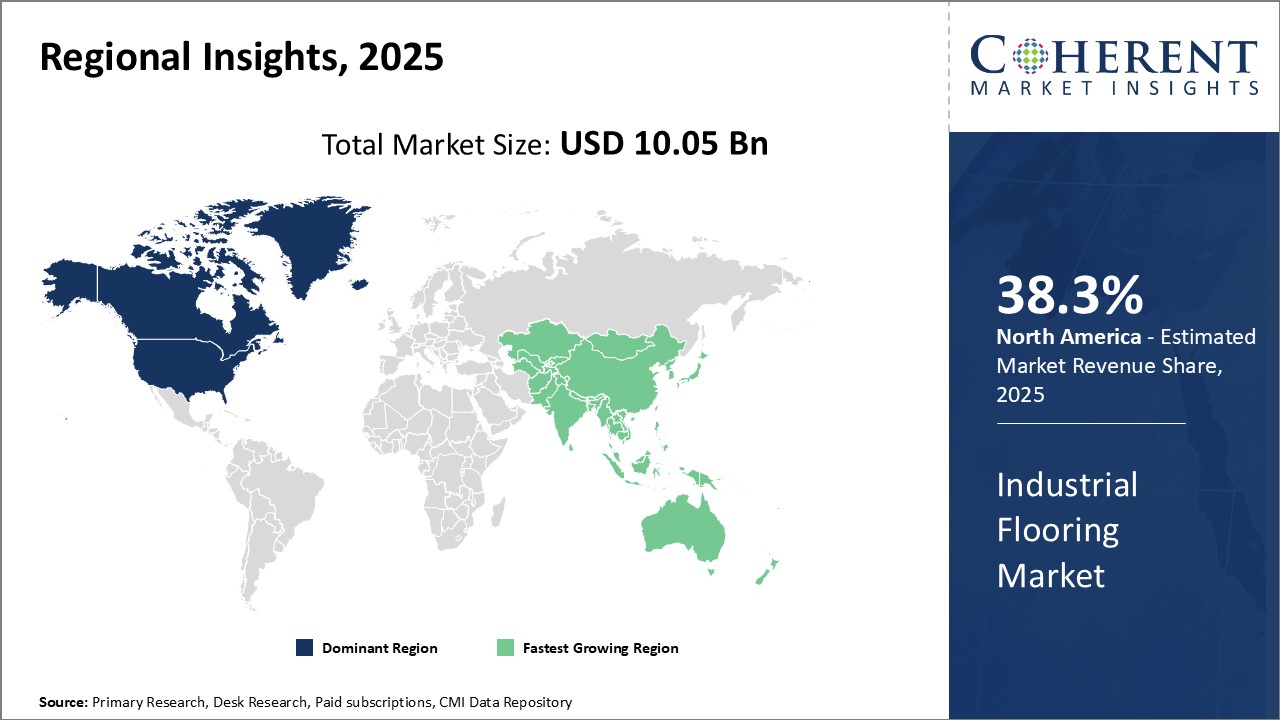Global industrial flooring market is estimated to be valued at USD 10.05 Bn in 2025 and is expected to reach USD 14.83 Bn by 2032, exhibiting a compound annual growth rate (CAGR) of 5.7% from 2025 to 2032.

Discover market dynamics shaping the industry: Download Free Sample
Global industrial flooring market is expected to witness significant growth over the forecast period due to rapid industrialization and increasing construction activities across manufacturing, automotive, food processing and other industries. Various industries are increasingly focusing on maintaining clean, dry and safe production floors with easy to clean and durable flooring solutions. Furthermore, growing emphasis on occupational health and safety across industries boosts adoption of anti-fatigue and slip resistant flooring. Technological advancements in flooring materials allowing higher strength, slip resistance and easier maintenance has gained popularity. Key market players are investing in research and development to offer innovative and sustainable industrial flooring solution, thus, catering to diverse industry requirements.
Rise of E-Commerce Operations
Rise of E-commerce operations across the globe has been a major driver for the growth of the global industrial flooring market. As more and more businesses are adopting hybrid or full e-commerce models, it has resulted in increased construction of large distribution centres and warehousing spaces to stock huge inventories and effectively manage online order fulfillments. These modern logistics facilities place heavy requirements on flooring in terms of withstanding high traffic, managing vibrations from heavy machinery, offering chemical resistance and catering to workplace safety and hygiene standards. Traditional concrete floors are unable to meet such demanding functionality needs. Industrial floorings crafted from raw materials like epoxy, polyaspartic polyurea, methyl methacrylate (MMA), etc. offer superior mechanical and chemical strength along with ease of cleaning and maintenance which have become indispensable for operations of third-party logistics (3PL) centres and e-commerce warehousing spaces. Their high durability, resistance to abrasion and indentation from forklifts along with non-slip resistance accords the operational efficiency needed in such fast-paced inventory handling facilities. They also allow for aesthetic designs and segmented overlay of logistics related signage/instructions on floors, thereby assisting in streamlining inventory movement and storage processes.

Get actionable strategies to beat competition: Download Free Sample
Emphasis on Safety and Ergonomics in Manufacturing SettingsIn industrial environments like manufacturing plants, safety is always a top priority where heavy machinery and repetitive job activities carry risks of accidents. As regulations have tightened and litigation has increased the costs of safety incidents, companies must proactively address workplace hazards to avoid costly penalties or lawsuits. Ergonomic flooring helps achieve this by reducing slipping, tripping, falling and other preventable issues. Manufacturing work often requires long shifts of employees standing, lifting, bending and performing the same motions continuously on hard surfaces. Over time, this can lead to fatigue, musculoskeletal discomfort and even serious injury without proper ergonomic considerations. Slip-resistant, cushioned industrial flooring helps minimize physical stresses and strains that contribute to accidents.
Key Takeaways of Analyst:
Global industrial flooring market is expected to witness growth in the near future due to rising industrial construction activities globally. The expansion of warehousing and logistics sectors, along with the rapid development of manufacturing industries in Asia Pacific and Middle East regions can drive the market growth. However, availability of substitutes such as vinyl tile flooring poses a challenge for widespread adoption of industrial flooring.
North America currently dominates the industrial flooring market owing to well-established industrial and manufacturing bases in the U.S. and Canada. However, Asia Pacific is expected to witness the fastest growth due to growing foreign investments in China, India, and Southeast Asia. Within Asia Pacific, China will likely remain the frontrunner due to the country's massive manufacturing industry and ongoing industrialization.
Epoxy coatings are gaining more preference than conventional options like concrete due to benefits like high durability and chemical resistance. Any new product launches that further enhance properties like abrasion resistance can gain popularity among industrial plant owners and operators.
Challenge: High initial costs
High initial costs associated with installation can hamper the market growth. Industrial flooring such as epoxy, polymer, and cement-based flooring have substantial upfront expenses that many industrial facility owners are hesitant to invest in. While these types of floors provide benefits like durability, chemical resistance, ease of cleaning, and longevity that save on maintenance costs in the long-run, the steep price tag of installation acts as a barrier, especially for smaller businesses with tight capital budgets. In addition to material costs, proper installation of industrial flooring requires stripping of the existing floor, repair work if needed, and skilled labor that follows strict application procedures. The specialized equipment, tools, and time needed for replacing an industrial flooring surface further contributes to the high initial expenditure.
Opportunity: Advances in flooring material technology
Advances in flooring material technology can offer an opportunity for growth of industrial flooring market. Industrial floors endure heavy usage, loads and exposure to harsh chemicals, thus, making durability and functionality top priorities. The development of advanced polymer composite materials is revolutionizing industrial flooring. These materials offer supreme strength and resilience as compared to traditional concrete while being much lighter weight. These can withstand temperatures from cryogenic to over 200°F and are nonconductive. Their monolithic, seamless quality helps prevent damage from impacts, cracks or punctures. These composite floors require little to no maintenance and have longer lifecycles, minimizing replacement and downtime costs.

Discover high revenue pocket segments and roadmap to it: Download Free Sample
Insights, By Product Type: Durability and cost-effectiveness can drive the light duty segment growthIn terms of product type, light duty (<300um) segment is estimated to contribute the 62.7% share of the market in 2025, owing to its optimal balance of durability and cost. Light duty floors offer sufficient strength and wear resistance for general industrial applications while maintaining a thinner and more economical installation footprint as compared to medium and heavy-duty options. The thin yet durable nature of light duty floors allows for use in areas with space constraints and uneven subsurface conditions without compromising integrity. Their flexibility accommodates minor substrate imperfections without bubbling or cracking. This makes light duty floors an ideal solution for remodeling and retrofitting existing industrial facilities with limited remodeling budgets. Light duty floors are sufficiently robust to withstand pedestrian and forklift traffic from routine material handling and maintenance activities. Their smooth, seamless surfaces simplify cleaning and improve hygiene. The low material requirements of light duty floors further enhance their cost appeal for maintenance departments and facilities managers aiming to complete repairs and upgrades affordably. The accelerated cure also allows light duty floors to return to service sooner after application for high-traffic areas like loading docks. The optimal strength-to-thickness ratio and economics of light duty floors made light duty floors the dominant choice for general use industrial spaces. Their blend of durability, flexibility and efficiency can boost demand for light duty <300um flooring products.
Insights, By Material: Unsurpassed chemical resistance boosts demand for epoxy
In terms of material, epoxy segment is estimated to contribute the 35% share of the market in 2025, due to its unrivaled resistance to corrosive substances. Epoxy resins form an impervious, cross-linked polymer that safeguards floors from a vast array of industrial chemicals. No other material delivers the same impermeability to liquids, acids, alkalis and solvents across pharmaceutical, food processing and specialty chemical industries. Facilities that handle corrosive or volatile chemicals require flooring impervious enough to contain spills and prevent seepage into drains or the subgrade. Epoxy satisfies stringent containment standards through a chemical-bonded monolithic membrane too dense for even the harshest chemicals to penetrate. It maintains an inert, non-reactive surface that does not catalyze dangerous reactions or leach constituents into stored or transferred substances. The ability to create seamless, joint-free epoxy floors eliminates cracks or fissures where chemicals could wick and collect over time. Jointless installations also facilitate compliant cleanup, since spill areas do not pool or pool in cracks. With proper applications exhibiting cohesive failure, epoxy floors release contained chemicals in solid sheets if damaged rather than as hazardous runoff.
Insights, By Application: Strict hygiene standards drives the healthcare segment growth
In terms of application, healthcare segment is estimated to contribute the 35.1% share of the market in 2025, due to its stringent hygienic flooring requirements. Hospitals, surgical centers, pharmaceutical clean rooms and medical laboratories demand seamless, non-porous, easily cleanable floors proven to inhibit bacterial and microbial growth. Healthcare facilities face immense liability if poor hygiene facilitates cross-contamination or infection. Porous or textured surfaces accumulate pathogens in crevices that prove difficult to sanitize thoroughly with commercial disinfectants. Continuous cleaning and disinfection are also mandated under various regulatory standards and accreditation guidelines. Seamless epoxy, MMA and urethane floors fulfill demanding R0-R9 cleanroom specifications through dense, non-porous surfaces hostile to microbes. Their chemical resistance withstands frequent exposures to bleach and sterilizing agents. Harmonized colors and jointless installations facilitate inspection for residues that could renew contamination. Cold-temperature curing allows installations without interrupting cleanroom protocols or necessitating room downtime for offgassing. Self-leveling applications self-heal minor abrasions to maintain an unworn, easily disinfected surface throughout a floor’s lifetime. Jointless continuity also prevents biological buildup at termination points. Compliant with critical USDA, FDA and other mandates, advanced medical flooring protects patients and staff by preventing pathogens’ refuge. Their hygienic properties satisfy increasingly rigorous oversight while streamlining maintenance routines. This drives the healthcare industry to contribute the highest demand within the industrial flooring application segment.

Need a Different Region or Segment? Download Free Sample
North America has dominated the global industrial flooring market for decades owing to its well-established manufacturing sector across industries such as automotive, food processing, chemicals and petrochemicals. The region accounts for 38.3% of the market share in 2025 due to presence of leading automakers, strong capital investments and favorable business policies supporting industries. With manufacturing contributing significantly to the GDP of both the U.S. and Canada, demand for industrial flooring to ensure safety, ease of operations and longevity of floors in production facilities has been consistently high. Further, North American players adopt the latest flooring technologies at a rapid pace to gain efficiencies. This gives domestic flooring brands a competitive edge over international brands in the regional market.
Asia Pacific has emerged as the fastest growing regional market for industrial flooring in recent years due to rapid industrialization across developing economies. Countries such as China, India, Indonesia, Vietnam and Thailand are witnessing double digit growth in their manufacturing output due to availability of low-cost skilled labor, improving infrastructure and governments supporting 'Make in Country' initiatives through incentives and subsidies. As these nations continue to strengthen their position in global manufacturing supply chains, demand for industrial flooring from industries such as automotive components, electronics, machinery equipment and heavy equipment has been rising sharply. Regional flooring brands have gained substantial market share through leveraging their understanding of customer requirements, procurement channels and ability to provide customized solutions at competitive rates. Moreover, the region has also become an attractive investment hub for leading global flooring companies seeking to expand their footprint in emerging markets.
Industrial Flooring Market Report Coverage
| Report Coverage | Details | ||
|---|---|---|---|
| Base Year: | 2024 | Market Size in 2025: | USD 10.05 Bn |
| Historical Data for: | 2020 To 2024 | Forecast Period: | 2025 To 2032 |
| Forecast Period 2025 to 2032 CAGR: | 5.7% | 2032 Value Projection: | USD 14.83 Bn |
| Geographies covered: |
|
||
| Segments covered: |
|
||
| Companies covered: |
BASF SE, Sika AG, RPM International Inc., Mapei U.K. Ltd., Fosroc, Don Construction Products Ltd., Cipy Polyurethanes Pvt Ltd., Viacor Polymer GmBH, Twintec, Acrylicon, Cornerstone Flooring, Applied Flooring, AVCON Technics Pvt. Ltd., 4m Europe, East Coast Flooring Ltd, Flowcrete, Tripolarcon Pvt Ltd., Wonderfloor, Chemoxy Flooring, Sterile Tech, Lanexis |
||
| Growth Drivers: |
|
||
| Restraints & Challenges: |
|
||
Uncover macros and micros vetted on 75+ parameters: Get instant access to report
*Definition: The industrial flooring market provides durable and protective flooring solutions for industrial environments. It offers products like epoxy floors, concrete floors, rubber floors, terrazzo floors etc. These floorings are designed to withstand harsh conditions, heavy foot traffic, chemical spills, moisture and other impacts inherent to industrial settings like manufacturing plants, warehouses, garages, machine shops, and more. The floorings are non-slip and easy to clean/maintain to ensure workplace safety, hygiene and productivity in industrial spaces.
Share
Share
About Author
Vidyesh Swar is a seasoned Consultant with a diverse background in market research and business consulting. With over 6 years of experience, Vidyesh has established a strong reputation for his proficiency in market estimations, supplier landscape analysis, and market share assessments for tailored research solution. Using his deep industry knowledge and analytical skills, he provides valuable insights and strategic recommendations, enabling clients to make informed decisions and navigate complex business landscapes.
Missing comfort of reading report in your local language? Find your preferred language :
Transform your Strategy with Exclusive Trending Reports :
Frequently Asked Questions
Joining thousands of companies around the world committed to making the Excellent Business Solutions.
View All Our Clients